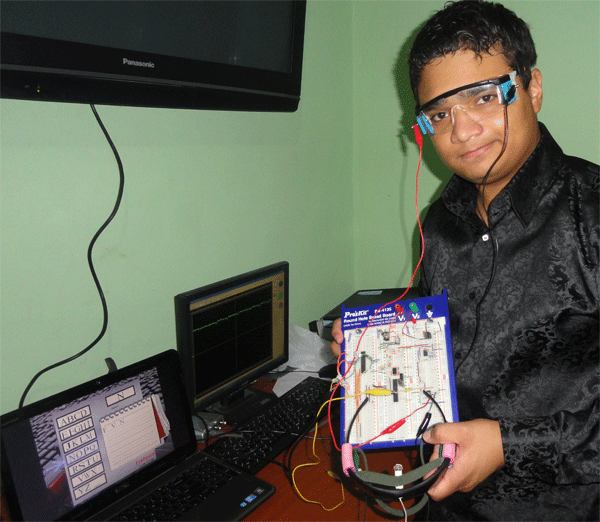
When 18-year-old Honduran maker Luis Cruz met a quadriplegic high school classmate and learned about the challenges he and other folks with disabilities face in the light of expensive assistive communication technologies, he was inspired to devise a solution. What Luis came up with is the Eyeboard: an inexpensive yet reliable human-computer interface that detects eye movements using electrooculography (EOG), a biomedical technique based on picking up signals from electrodes placed around the eyes, which in this case enables users who can’t manipulate a mouse or trackpad to move a cursor on a screen. Luis wrote about his project in an eye tracking feature on the pages of MAKE Volume 29, alongside Zach Lieberman’s EyeWriter project. Here is Luis’ article on the Eyeboard design and development:
The eyeball generates a voltage of 0.4mV–1.0mV (millivolts) between its cornea in front and retina in back. If you attach electrodes on opposite sides of the eye, they’ll pick up some of this voltage, depending on where the eyeball is pointing. Looking straight ahead, with the cornea and retina equidistant between the electrodes, there will be no voltage. But with the eyeball angled to one side, you can measure a microvolt-level signal between the
electrodes nearer the cornea and the one opposite. EOG can track both horizontal and vertical movements, but horizontal is easier and more useful. My system, like many others, only tracks horizontal using 3 electrodes: one right next to each eye,and the ground electrode centered on the bridge of the nose or forehead.A processor chip or even an oscilloscope cannot detect such small voltages, so the EOG system must amplify them, while also filtering out any noise from nearby electrical devices and wiring. You can see the circuit I built to accomplish this, along with step-by-step instructions for building my EOG system and programming its microcontroller chip, at makeprojects.com.
To amplify the signal initially, I use an INA118 instrumentation amplifier chip configured with a 100Ω resistor between pins 1 and 8, which gives it a gain of 501. The INA118 chip’s high CMRR (common-mode rejection ratio) of 110dB eliminates common signals that go into both inputs, which removes some noise at the start of the signal path.
Noise from electrode circuits tends to come at high frequencies, so mine uses 2 passive low-pass filters in sequence, to reduce this noise above their cutoff frequency of around 16Hz. With the circuit I used, the formula for the cutoff is 1 /2πRC, where R is resistance and C is capacitance, so with a 100kΩ resistor and a 0.1µF cap, this comes out to 15.9Hz, which is fine; eye movements aren’t so fast that filtering cuts out anything important.
Finally, a capacitor zeroes the signal by removing the DC offset added by the resting potential between the eyes, and a voltage follower circuit lets you connect a higher source impedance device than the EOG output’s impedance, which is useful to connect an oscilloscope or multimeter for troubleshooting. To power the system, I use two 7805 voltage regulators wired in a trick way to supply the circuit with +5V, –5V, and ground (0V), eliminating the need for a dual power supply.
To process the amplified signal when the eyes move horizontally, I feed it into the analog-digital converter pin of an AT-mega328P microcontroller that’s programmed to send the data to a computer via serial port. A Python script on the computer then sends the data to a C++ applet I wrote, which lets the user spell out messages. Looking to the left scrolls down through letters, and looking to the right selects them. To make wearing the electrodes more comfortable, I mounted them to some glasses modded with a headband and super glue. I’ve built several prototypes of these EOG glasses with good results.
I’m still improving this EOG system, including looking for ways to make it more comfortable to wear. I’m pleased to have developed a system for less than $200 that enables disabled people, like my classmate, to communicate, when commercial versions of the same cost a minimum of $10,000. I’d also like to create inexpensive EOG-interface systems for other applications, such as controlling a wheelchair or a television. I just graduated from high school, and what I need most of all in order to pursue these ideas is a scholarship, sponsor, or other funding source so that I can study electrical engineering in the United States.
Here’s the Reuters coverage of Luis’ project from December 2011:

Build your own Eyeboard by following the instructions Luis shared on Make: Projects.
From the pages of MAKE Volume 29:
We have the technology (to quote The Six Million Dollar Man), but commercial tools for exploring, assisting, and augmenting our bodies really can approach a price tag of $6 million. Medical and assistive tech manufacturers must pay not just for R&D, but for expensive clinical trials, regulatory compliance, and liability — and doesn’t help with low pricing that these devices are typically paid for through insurance, rather than purchased directly. But many gadgets that restore people’s abilities or enable new “superpowers” are surprisingly easy to make, and for tiny fractions of the costs of off-the-shelf equivalents. MAKE Volume 29, the “DIY Superhuman” issue, explains how.
ADVERTISEMENT







